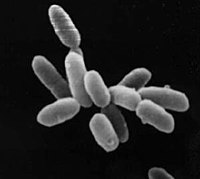
Photo from wikipedia
The effects of graphite on the anaerobic digestion of food waste (FW), cow manure (CM) and its mixture (FW/CM) via batch experiments under mesophilic conditions have been investigated in this… Click to show full abstract
The effects of graphite on the anaerobic digestion of food waste (FW), cow manure (CM) and its mixture (FW/CM) via batch experiments under mesophilic conditions have been investigated in this study. Maximum biogas production with graphite addition for FW + 1 g/L, CM + 1.5 g/L and FW/CM + 0.75 g/L are 1128.46, 829.6 and 1471.1 mL/gVS respectively. Additionally, this study investigates the link between microbial community structure and biogas production when graphite addition of anaerobic digester was conducted. Based on 16S rRNA gene amplicon sequencing results, Aminiphilus (13-14%), Actinobaculum (13-15%) and Clostridium (12-18%) were the predominant bacterial genera in graphite-added FW, CM and FW/CM reactors, respectively. Comparatively higher biogas production of FW/CM synergistically affected by abundances of Clostridium as well as co-digestion in this anaerobic digestion setup. Methanosaeta was the most abundant methanogen in the graphite added digesters; however, the relative abundance of these genera was different.
Journal Title: Bioresource technology
Year Published: 2020
Link to full text (if available)
Share on Social Media: Sign Up to like & get
recommendations!